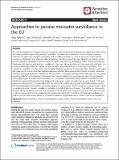Por favor, use este identificador para citar o enlazar a este item:
http://hdl.handle.net/10261/109762COMPARTIR / EXPORTAR:
 SHARE SHARE
 CORE
BASE CORE
BASE
|
|
| Visualizar otros formatos: MARC | Dublin Core | RDF | ORE | MODS | METS | DIDL | DATACITE | |

| Título: | Approaches to passive mosquito surveillance in the EU |
Autor: | Kampen, Helge; Medlock, J.M.; Vaux, A. G. C.; Koenraadt, Constantianus J. M.; van Vliet, Arnold J. H.; Bartumeus, Frederic CSIC ORCID ; Oltra, Aitana CSIC ORCID ; Sousa, Carla A.; Chouin, Sébastien; Werner, Doreen | Palabras clave: | Vectors Mosquito inventory Passive surveillance Community participation Citizen science Invasive mosquitoes |
Fecha de publicación: | 8-ene-2015 | Editor: | BioMed Central | Citación: | Parasites & Vectors 8: 9 (2015) | Resumen: | The recent emergence in Europe of invasive mosquitoes and mosquito-borne disease associated with both invasive and native mosquito species has prompted intensified mosquito vector research in most European countries. Central to the efforts are mosquito monitoring and surveillance activities in order to assess the current species occurrence, distribution and, when possible, abundance, in order to permit the early detection of invasive species and the spread of competent vectors. As active mosquito collection, e.g. by trapping adults, dipping preimaginal developmental stages or ovitrapping, is usually cost-, time- and labour-intensive and can cover only small parts of a country, passive data collection approaches are gradually being integrated into monitoring programmes. Thus, scientists in several EU member states have recently initiated programmes for mosquito data collection and analysis that make use of sources other than targeted mosquito collection. While some of them extract mosquito distribution data from zoological databases established in other contexts, community-based approaches built upon the recognition, reporting, collection and submission of mosquito specimens by citizens are becoming more and more popular and increasingly support scientific research. Based on such reports and submissions, new populations, extended or new distribution areas and temporal activity patterns of invasive and native mosquito species were found. In all cases, extensive media work and communication with the participating individuals or groups was fundamental for success. The presented projects demonstrate that passive approaches are powerful tools to survey the mosquito fauna in order to supplement active mosquito surveillance strategies and render them more focused. Their ability to continuously produce biological data permits the early recognition of changes in the mosquito fauna that may have an impact on biting nuisance and the risk of pathogen transmission associated with mosquitoes. International coordination to explore synergies and increase efficiency of passive surveillance programmes across borders needs to be established. | Descripción: | 13 páginas, 5 figuras | Versión del editor: | http://dx.doi.org/10.1186/s13071-014-0604-5 | URI: | http://hdl.handle.net/10261/109762 | DOI: | 10.1186/s13071-014-0604-5 | ISSN: | 1756-3305 | E-ISSN: | 1756-3305 |
| Aparece en las colecciones: | (CEAB) Artículos |
Ficheros en este ítem:
| Fichero | Descripción | Tamaño | Formato | |
|---|---|---|---|---|
| Aitana 2014.pdf | 3,03 MB | Adobe PDF |  Visualizar/Abrir |
CORE Recommender
PubMed Central
Citations
51
checked on 11-mar-2024
SCOPUSTM
Citations
95
checked on 15-abr-2024
WEB OF SCIENCETM
Citations
92
checked on 23-feb-2024
Page view(s)
479
checked on 18-abr-2024
Download(s)
242
checked on 18-abr-2024
Google ScholarTM
Check
Altmetric
Altmetric
Artículos relacionados:
NOTA: Los ítems de Digital.CSIC están protegidos por copyright, con todos los derechos reservados, a menos que se indique lo contrario.
